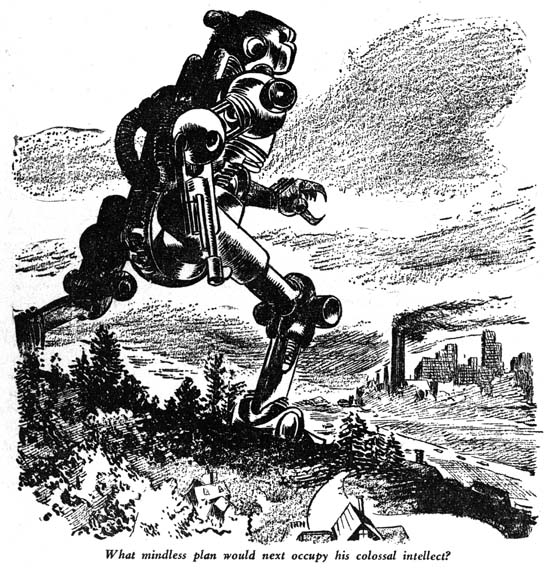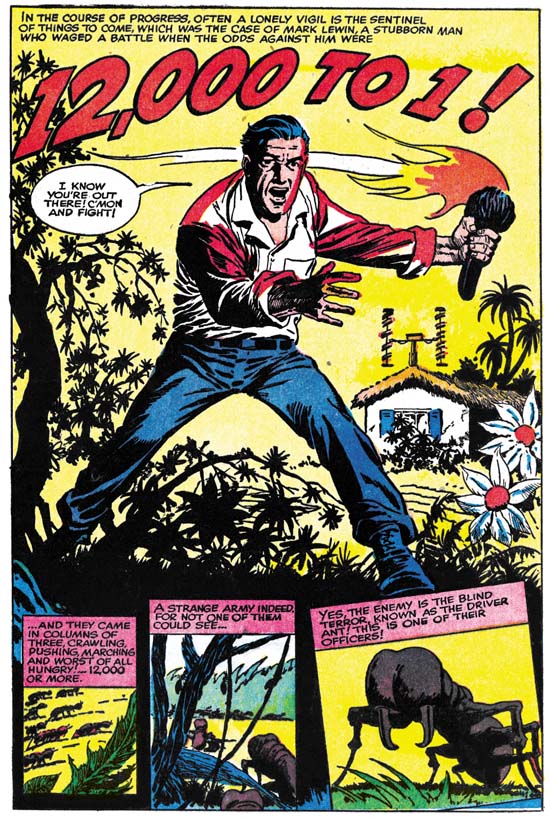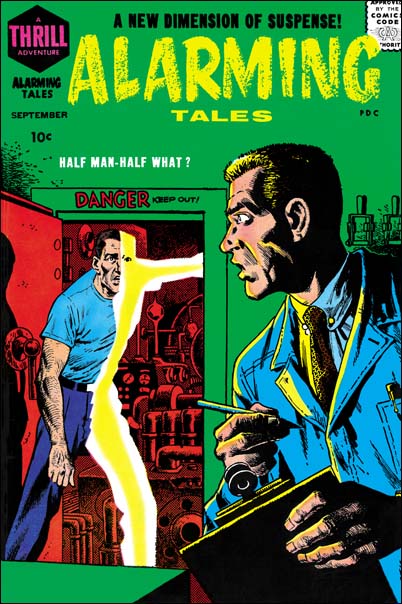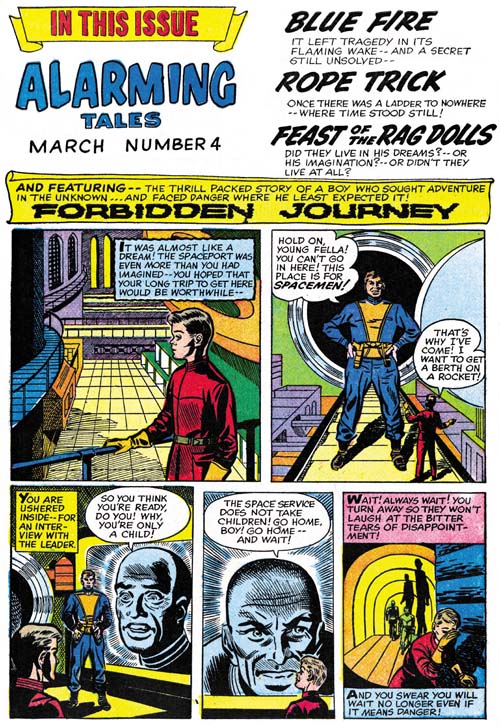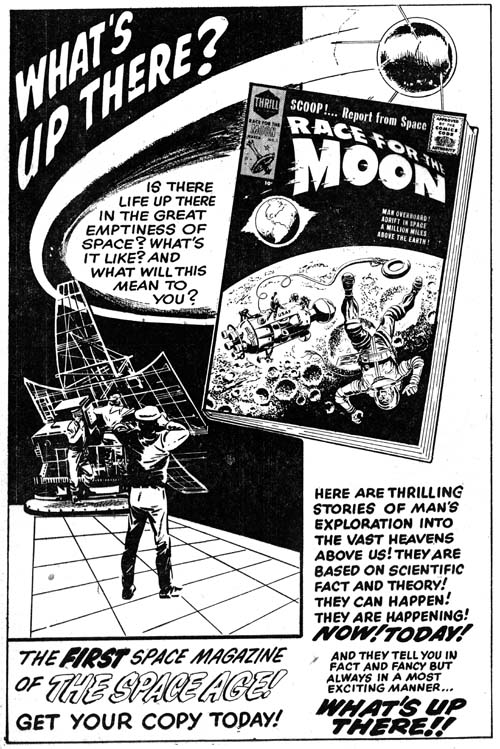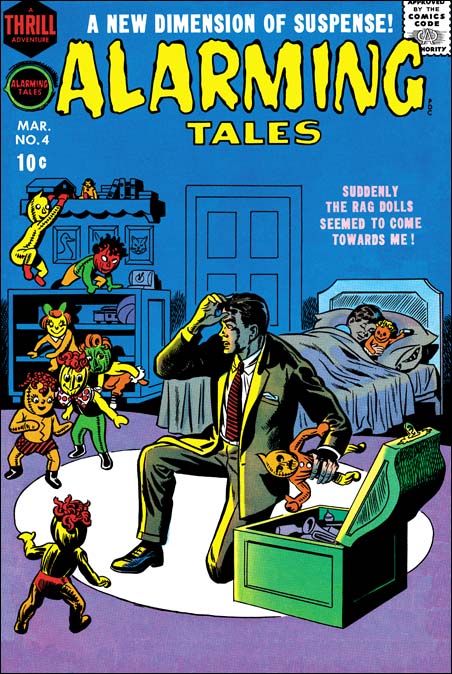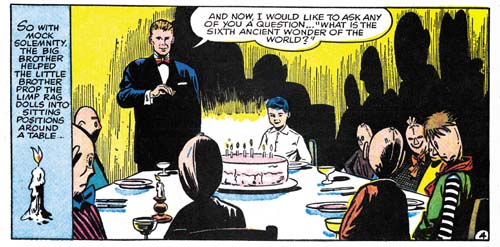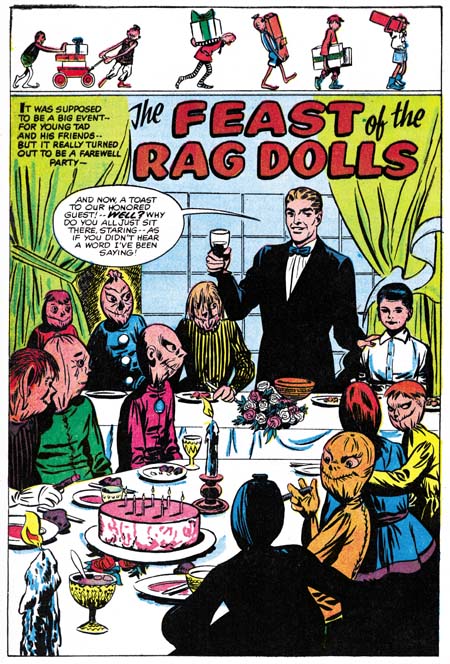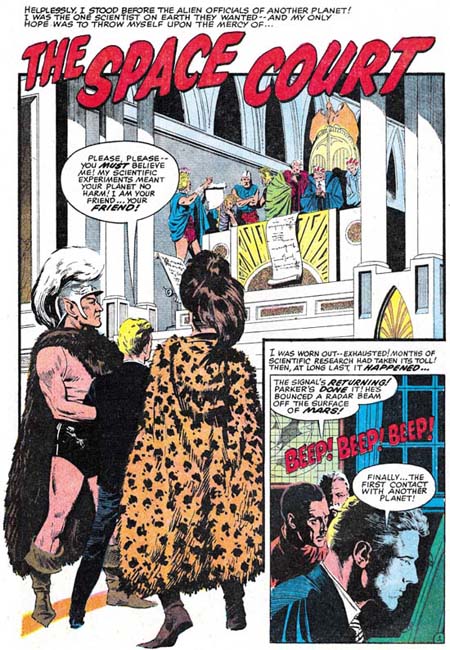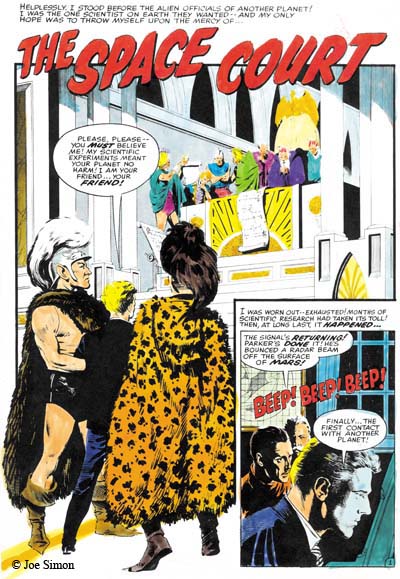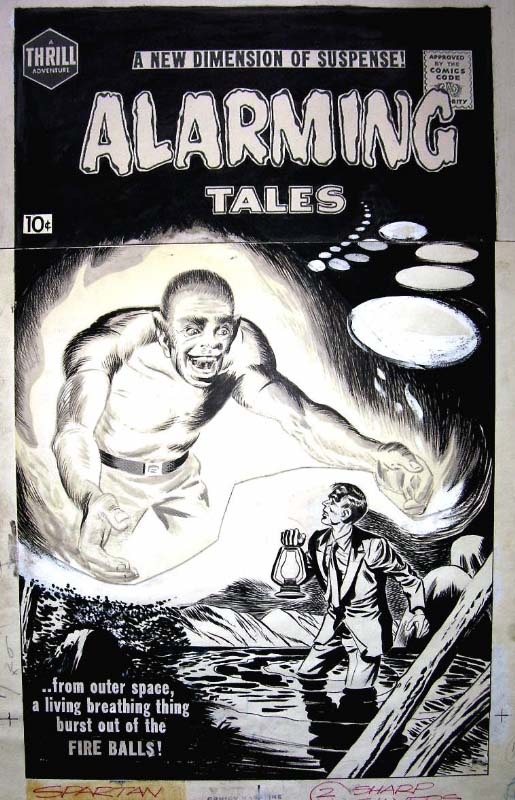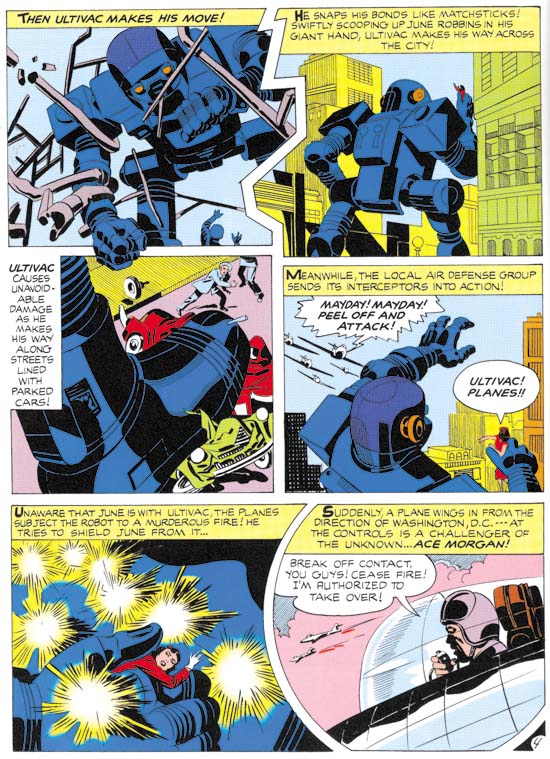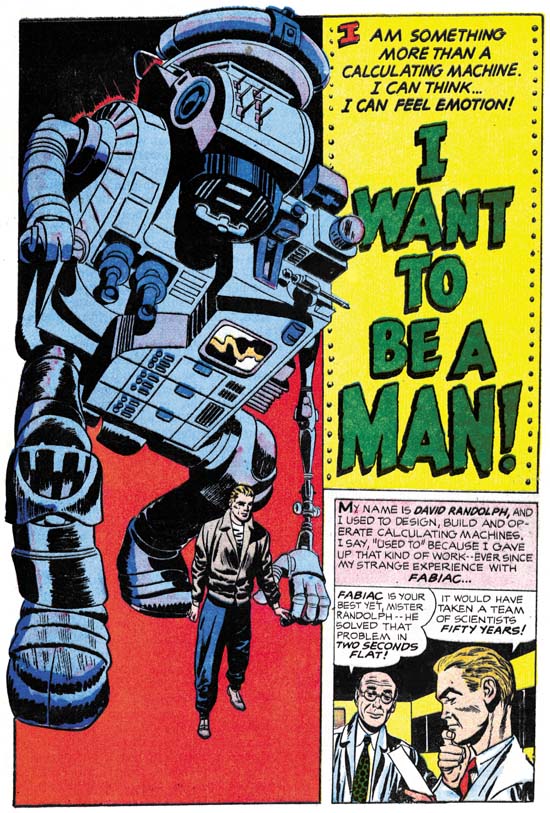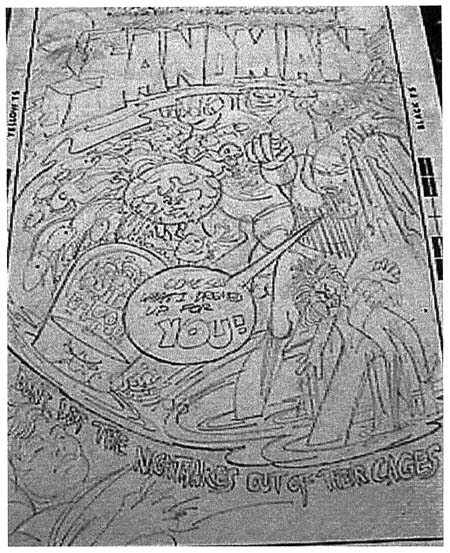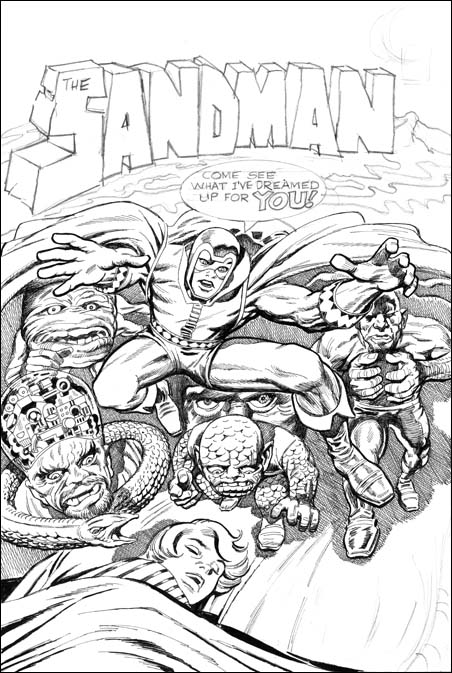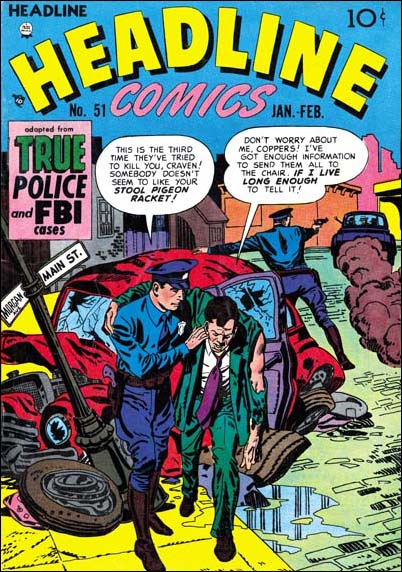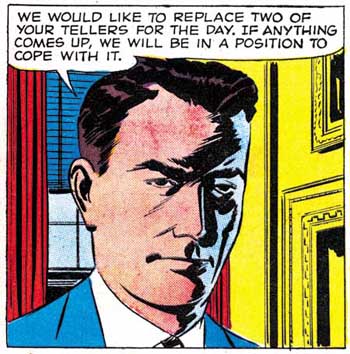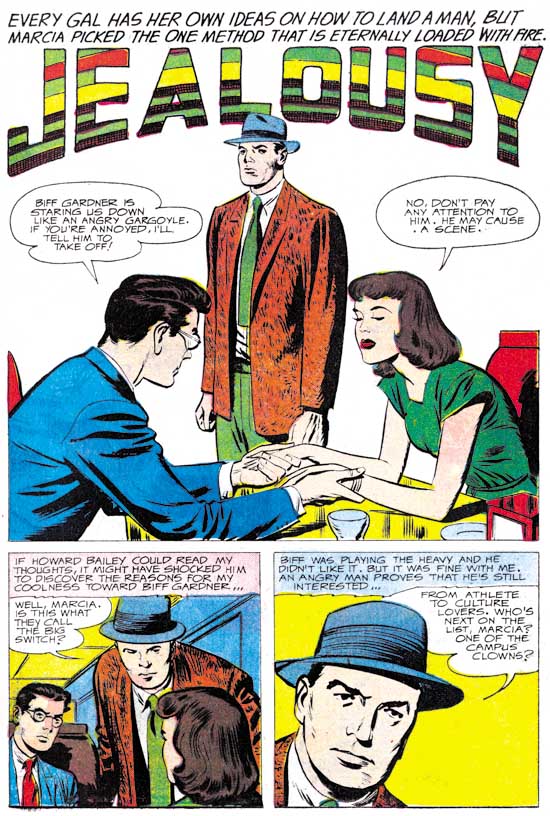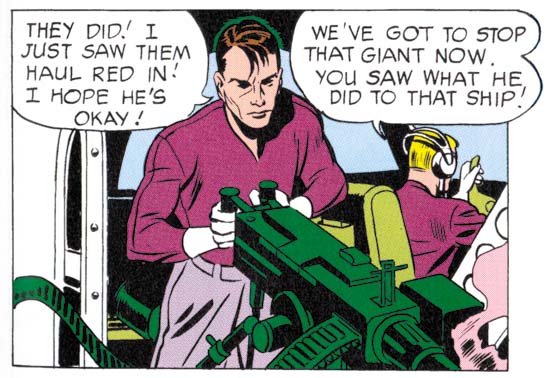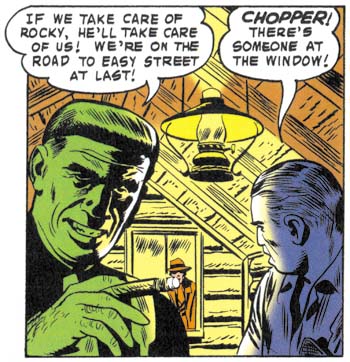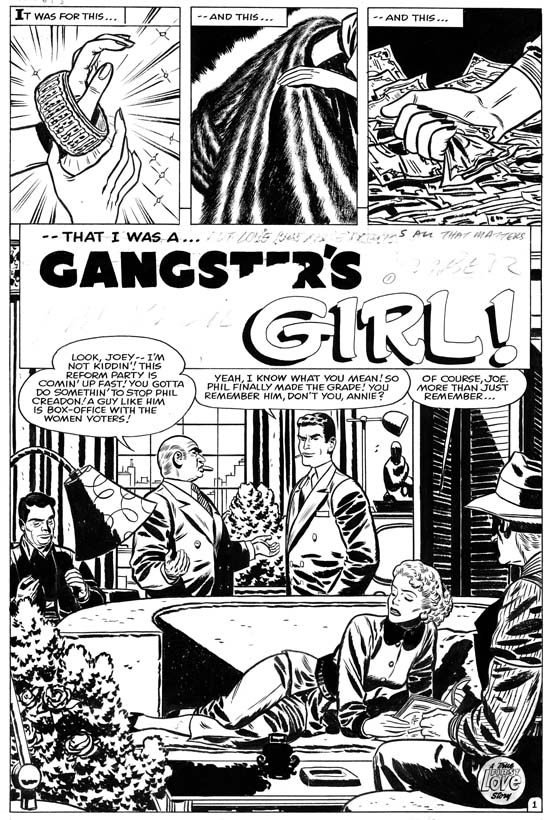
Gangster’s Girl” original art by Bill Draut published in First Love #69 (October 1956) as “Remember, I’m Your Girl”
We are on location for the filming of a television drama. Suddenly someone taps the director on his shoulder and hands him a cell phone. We cannot make out the conversation but it is obvious the the director is very unhappy. He gives the phone back to his assistant and then calls out “Get the author, we have to do a rewrite”.
Well I do not know how often this sort of thing happens but I have heard of various movies under going a series of rewriting of the script. In the comic book industry of the 50’s such rewrites were very unusual. Sure a word here or there would be changed or some art editing performed, but generally the story was published as it was originally scripted. With a product that was sold for ten cents and with smaller print runs, care was taken to avoid waste when producing the comic. The most frequent reason for comic book rewrites resulted when a title was cancelled. Because the art was created well before publication, a cancelled title would often result art in various stages of work including some that was fully complete. Such art might have to be rewritten in order to publish it in some other title. But baring recycled art, it was unusual for a comic book story to be extensively rewritten.
Not too long ago I posted on a Bill Draut story “Remember, I’m Your Girl”. Shortly after my blogging on it some of my readers pointed out to me that the art for the story was up for sale on eBay. However the image on the eBay listing showed the story title was “Gangster’s Girl”. I was intrigue and although I felt the art was not the best that Bill Draut had done, I put in what turned out to be the winning bid.
Also included with the art that I received was the text paste-ups that had come off or been removed. I did not think much about the paste-ups at the time because I thought they would just be the text as it was finally published. Later I would find I was wrong. Like most of the art for S&K productions, there was little on the margins except for a few production instructions. However you could tell that that was not always the case because an eraser had been used on the margins. So I scanned the art and did some processing in Photoshop. This allowed me to bring out some of the erased pencils. I also did some work to bring out the color blue because some blue pencil markings had also been erased. Armed with the original art, the paste-ups and enhanced scans I could do an analysis as if I was some sort of comic book archeologist. I can now outline the steps in the process of converting the story from the original “Gangster’s Girl” to “Remember, I’m Your Girl”.
The Photoshop enhancements did bring out some erased pencils that probably date from the when the art was first produced. Inside some of the captions and balloons there can be seen some of the text in pencil. It was standard for the S&K shop to have all the text placed on the art before the final lettering was done. I am not clear on whether the penciling of the text was done before the art was penciled, or if it was done by the penciler or the letterer. Also from the original state of the art, each page had in pencil the story title on the upper left and Bill Draut’s address on the upper right margin. The handwriting seems the same for the two, and I suspect that it was Bill’s but I have nothing to compare it with.
The original art no longer has any of the paste-ups still attached. This meant that the original story could be read in full. The only exception was that one word balloon had been inked over. But by viewing the art at an angle the pencils show up and it was possible to read the original text.
The story is a love triangle between Joe (a gangster), Annie (the love interest) and Phil (former friend). Phil’s running for election on a clean up campaign is a clear threat to Joe. Joe asks Annie to get close to Phil in order to find weaknesses, overcoming her reluctance with expensive presents. Annie stages a meeting with Phil and a romance ensues. Phil looses the election but Annie says she will stay with him. During a confrontation between Joe and Phil, Joe shows Annie one of his presents, a mink coat. Enticed by Joe’s rich presents, Annie decides to stay with Joe.
That is right, in the end the gangster gets the girl. This has got to be the most unusual story from a romance comic that I have ever read. Not only that, it is probably the best. My story outline does not give it justice, in particularly how Annie’s weakness is portrayed. But this story was published in 1956. Who in their right mind would think that this story could get Comic Code approval? I do not know how to explain this lapse. Perhaps it was actually produced before the Comic Code but had somehow never been used.
Well someone realized that the story would have to be altered if it was to be published. So the first rewrite was performed. That is right, there were actually three versions of the story. For the second story Joe became a big businessman. All the details of the second story cannot be reconstructed. It is not clear whether Joe still uses expensive gifts to get Annie to spy on Phil, or if instead the final version of the plot was used. Fortunately the end can be reconstructed and surprising Joe still gets Annie in the end. Only it is not the expensive gifts that changes her mind, it is the fact that she detects that Phil does not trust her enough to reject those gifts. The confrontation has made Joe realize his own failings, he decides to marry Annie and changes his ways.
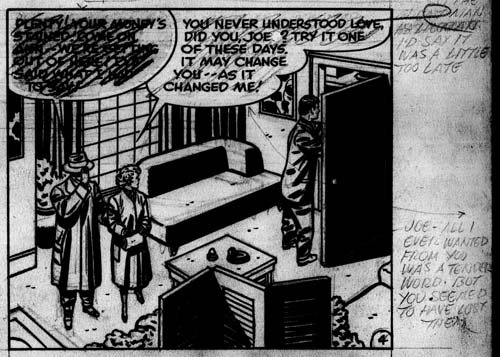
Page 4 editing changes for the first rewrite from the Photoshop enhanced scans.
A lot of text had to be changed in the rewrite. First a pencil was scribbled over whatever was going to be replaced. Then the new version was written in pencil generally in the margins but for small changes it might be done nearer. The above image of the Photoshop enhanced image shows an example from page 4. In the lower right is the new text for the second balloon:
JOE – ALL I EVER WANTED FROM YOU WAS A TENDER WORD. BUT YOU SEEMED TO HAVE LOST THEM.
This rewrite was only used for the second story, the third story reverted back to the original script. That is why the pencils scribbling over the second balloon are lighter then those for the first balloon. The second balloon scribbling was erased and are hardly visible on the art without Photoshop adjustment.
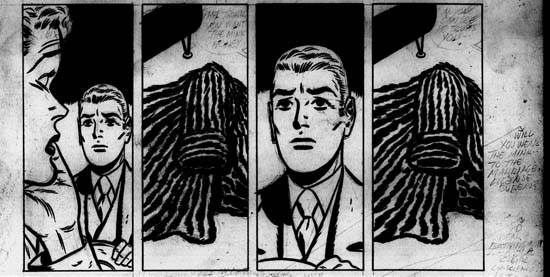
Page 5 from the Photoshoped enhanced scans.
The final page had a very effective series of panels showing Annie trying to make her final choice. In all versions of the story this appears to have been without any text. But the enhanced scans show that for a time word balloons were considered. The one in the second panels says:
PHIL THINKS YOU WANT THE MINK HONEY
The last has:
ANYONE CAN SEE HE TRUSTS YOU —
Since both statements deal with trust I believe these changes were considered for the second version of the story where Phil’s lack of trust causes Annie to choose Joe. But thankfully this version did not make it into the second story and was never inked. This set of panel “speaks much loader” without the use of any words.
The margin rewrites look to me to be in Joe Simon’s hand writing. But to be sure I will be showing them to Joe on my next visit to see what he thinks.
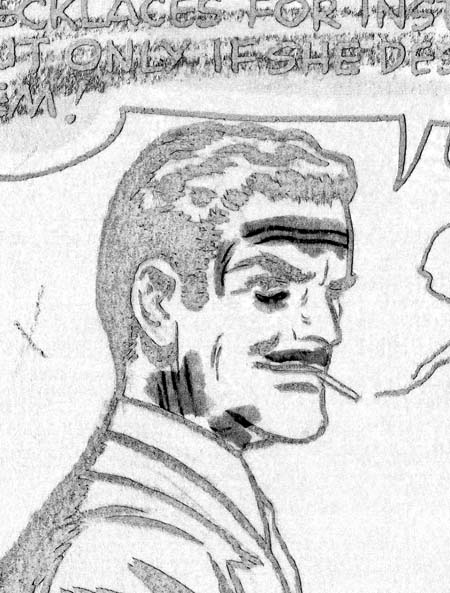
Close-up from page 2 filtered for blue.
The rewrite was done in a way that not much art had to be altered. A classic technique used to change art is the use of whiteout. Here there is not a lot of use of whiteout in the art. You can tell that some whiteout was used by Draut because the inking over it is his. That particular whiteout use had nothing to do with the rewrite. Whiteout was also used on Joe’s face and this does seem related to the rewrite because it was not re-inked. Of course the whiteout obscures the art that has been changed but the filtering for blue in Photoshop sometimes allows us to see through the whiteout. As can be seen in the example above Joe originally had wrinkles, jowls and a mustache. As a powerful gangster Joe was older because the appeal he had for Annie was based solely on his money. The whiteout changes were done to make him younger.

Close-up from bottom of page 1 filtered for blue.
When I examined the art I found a couple of spots that were inked by another artist. For example in the foreground of the splash panel there is a table with a funny shadow and an unusual vase-like object. By looking at an angle at the art I could see the original pencils. Unfortunately I cannot scan at an angle but I found that further manipulation of the blue filtered scan sometimes brings out the pencils to a certain degree. In the image above you can see that the shadow hides a gun laying on the table and that the vase-like object was originally a glass. Drinking and the use of guns is appropriate for a gangster, but not for a business man, even a shady one. The Comic Code was very sensitive to anything that might “corrupt” the morals of the young readers. Similar re-inking hides guns a couple other places in the story.
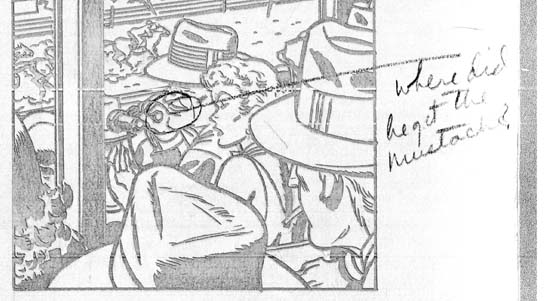
Close-up from page 3 filtered for blue
With the art changes made and the altered scripts pasted into their proper places, the second version of the story was ready to go. The next individual to work on the story used blue pencil to indicate certain changes. ‘X’s were placed in the margins at certain spots and other editing marks were made. These marks are all somewhat cryptic because for the most part they are not accompanied with any remarks. This blue penciling was done after the first rewrite because in some places it extends over the paste-ups. Once it even indicated a change to be made on a paste-up. Interestingly not all the changes indicated by the blue pencils were ever made. One is shown in the image above. There a circle was made around Joe connecting to a comment
where did he get the mustache?
Sure enough this was the one place that whiteout had not been used to remove Joe’s original mustache. But for some reason this was never corrected.
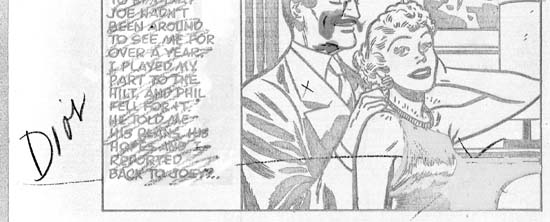
Close-up from page 3 filtered for blue.
On the third page the art had a blue pencil notation leading to an area with an ‘X’ (see above image). Again looking at an angle I could make out the original pencils. In this case the pencils showed a part of Annie’s anatomy that, let us just say, normally would not be visible with her dress on. I have heard of artists fooling around like that but I think we can be pretty confident that this was not included in the inked version and therefore was not the problem. But there is an indication that perhaps Annie was shown more busty then desirable for the Comic Code. Rather then whiting it out and re-inking, the area was just filled with black so that Annie’s profile was no longer distinguishable.
The way the blue pencil was used leads me to believe that the art had been presented to someone at Harvey for approval. In his book, “The Comic Book Makers”, Joe describes presenting Silver Spider to Leon Harvey, so perhaps Leon was responsible for the blue pencils in “Remember, I’m Your Girl”. In any case I suspect all the blue ‘X’s indicated that the second version of the story had not gone far enough. This resulted in the second rewrite.
In the third and final version of the story Joe becomes Annie’s brother and now became a shady politician. Of course all mention of a romantic connection or marriage between the two had to be removed. I am not sure what type of person Annie was in the second version, but in the final she is clearly given a more moral character. Although she accepts gifts from Joe she refuses to arrange to spy on Phil. But fate intervenes with an accidental meeting between Annie and Phil after which the story continues pretty much as before. However in the final confrontation Annie goes off with Phil leaving Joe all alone.
The same person who did the first rewrite did the second one as well. And the same technique of writing the altered version in the margins was used. Some of these new notes were done over erased portions of previous notations. This not only made it impossible to read large portions of the earlier versions, but some portions of the latest are hard to make out as well.
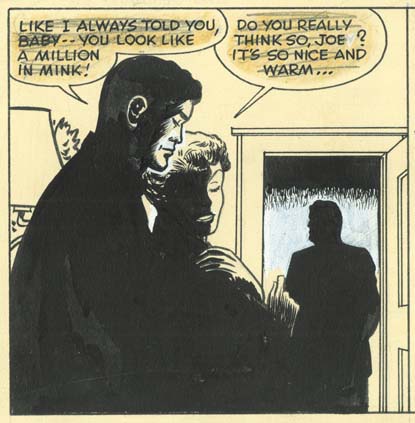
Page 5 final art panel from a normal scan of the original art.
Most of the art changes were done with the first rewrite. An exception is the art for the last panel was dramatically changed for the last version. The two foreground figures are now shown largely as silhouettes. However a careful examination of the inking shows that this was not always the case, some of the original spotting can be made out on the original (but not in the image I supply). The doorway was also modified. Whiteout has been used to cover up a dark background that original extended much further down the doorway. The background figure is a silhouette as well, but I wonder if it was originally. Regrettably it is not possible to detect any original spotting or pencils. These changes were made because in the last version of the story Phil, not Joe, gets the girl. The making of the foreground figures as silhouettes was done because originally Annie was wearing her mink coat. The change in the background was done to change the original looser Phil into Joe, a silhouette being easier to do then a full re-inking.
The story ends with a vertical caption. Because all the different versions of the story had unique endings, this caption was changed for each of the rewrites. Fortunately when the second rewrite was done the paste-up from the first rewrite was peeled off, flipped over and reused. Therefore all versions of the final caption have been preserved. These are the endings in the order that they were written.
OKAY… SO I SOLD MYSELF… CHEAP! I LOVED PHIL… BUT I LOVED JOEY’S MONEY MORE! SO WHAT? LOVE ISN’T THE MOST IMPORTANT THING IN THE WORLD IS IT? BUT I WONDER WHY SOMETIMES, IN THE NIGHT I CRY…
PHIL HAD MADE UP MY MIND FOR ME– EXPECTING ME TO TAKE JOE’S MINK COAT. HE HAD EVERY SHINING QUALITY– EXCEPT TRUST! I WAS GLAD I CHOOSE JOE. HE KEPT HIS PROMISE. HE LEARNED TO BE TENDER!
JOE WAS ALONE, NOW– WITHOUT FRIENDS OR FAMILY! THE FUTURE WAS UP TO HIM– HE COULD WALK TO HIS DOOM DOWN THE SIDE STREETS OF SHADY POLITICS OR WALK INTO THE SUNLIGHT WITH HIS HEAD HIGH– AS I HAD!
The story line for the last two versions are not nearly as good as the first. That is just the nature what had to be done to alter the story so that it could get Comic Code approval. When you keep that in mind, the rewrites are impressive particularly since they required only limited changes to the art.
